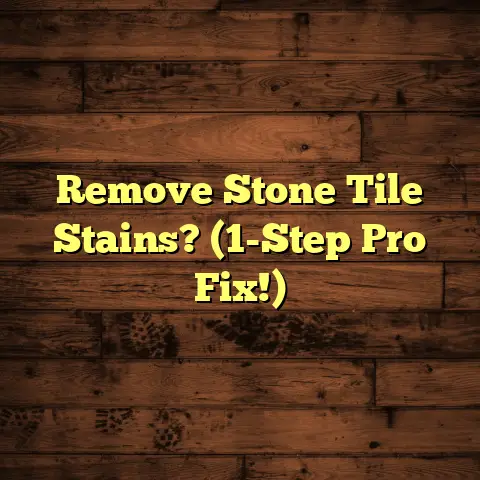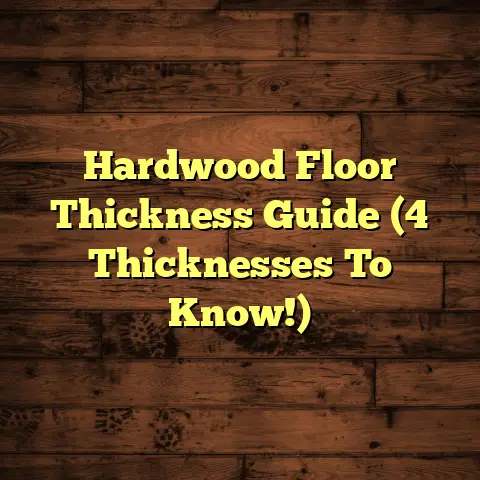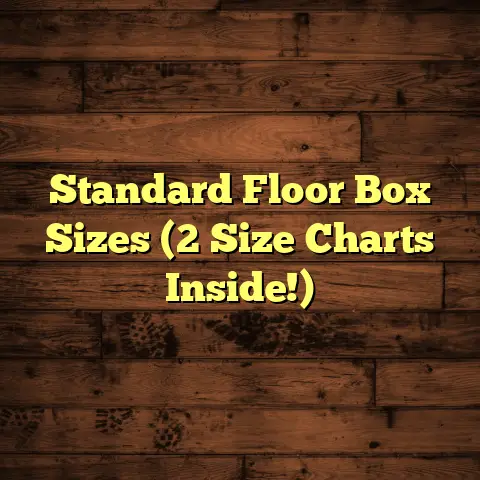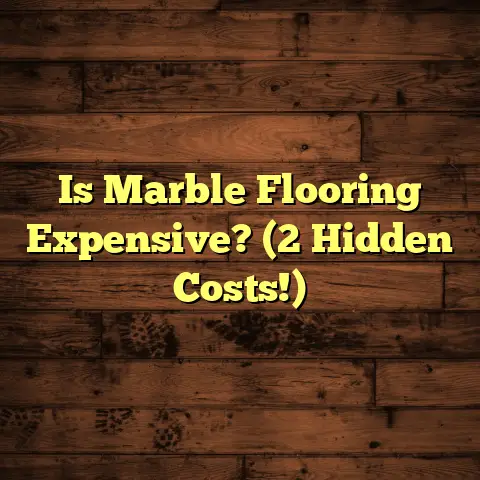Clean Old Wax Off Floors: Easy Guide (4 Product Fails!)
Okay, let’s be real.
We’ve all been there.
You inherit a house,
stumble upon a vintage find, or just neglect your floors a
little too long.
Suddenly, you’re staring down a
monster: layers and layers of old, yellowed wax.
It’s not just a cleaning task; it feels like
an archeological dig.
You’re chipping away at history,
and not the good kind.
The kind that screams,
“Help me!
I haven’t seen a good cleaning in decades!”
What’s hiding underneath that waxy tomb?
Maybe it’s
beautiful, gleaming hardwood, or perhaps a sleek
laminate just begging to reflect some light.
But first, you have to conquer this waxy beast.
In this guide, I’m going to walk you through the
process of removing old wax.
I’ll share the secrets
I’ve learned over years of flooring work.
Plus, I’ll expose four products that absolutely
bombed when I tried to use them for wax removal.
Trust me, you’ll want to learn from my mistakes!
Section 1: Understanding the Enemy – The Science of Old Wax
So, what is this stuff we’re fighting?
Floor wax, in its simplest form, is a protective
coating.
Traditionally, it was made from natural waxes
like carnauba or beeswax, mixed with solvents to make
it spreadable.
Now, you’ll find synthetic versions too.
The idea is that the wax creates a barrier, protecting
the floor from scratches, spills, and everyday wear
and tear.
But here’s the problem: wax isn’t a
“one-and-done” application.
Over time, wax layers build up.
Each new coat traps
dirt and grime.
The solvents evaporate, leaving behind
a thicker, duller, and often yellowed residue.
Think of it like adding layers of paint to a canvas
without ever cleaning it.
It gets messy fast!
And different floor types react differently to wax buildup. Here’s a quick breakdown:
- Hardwood: Wax was traditionally used on hardwood. But too much can suffocate the wood, preventing it from breathing and leading to moisture problems. The buildup also hides the natural beauty of the wood grain.
- Laminate: Laminate flooring typically doesn’t need wax. In fact, wax can damage the protective layer and leave a sticky residue that’s almost impossible to remove.
- Tile: Wax is sometimes used on tile to give it a shine. But it can also make the tile slippery and attract dirt, especially in grout lines.
- Vinyl: Similar to laminate, vinyl flooring usually doesn’t require waxing. Wax can dull the finish and make it harder to clean.
Imagine peeling back layers of time, revealing a floor
that was once vibrant and full of life.
It’s like
unearthing a treasure buried beneath years of neglect.
That’s the reward waiting for you if you can conquer
the wax!
Section 2: The Tools of War – What You’ll Need
Alright, time to arm ourselves!
Removing old wax
requires the right tools and materials.
Here’s what
I recommend having on hand:
- Wax Stripper: This is your primary weapon. Choose a stripper specifically designed for your floor type. Avoid anything too harsh, as it could damage the finish. I’ll talk more about this later (and why some are terrible!).
- Soft Cloths or Mop: You’ll need plenty of these for applying the stripper and wiping away the dissolved wax. Microfiber cloths work best.
- Scrub Brush: A soft-bristled scrub brush can help loosen stubborn wax buildup, especially in corners and along edges.
- Plastic Scraper: For really tough spots, a plastic scraper can be your best friend. Avoid metal scrapers, as they can scratch the floor.
- Buckets: You’ll need at least two buckets: one for the stripper solution and one for clean water.
- Safety Gear: Gloves are essential to protect your hands from the chemicals in the stripper. Eye protection is also a good idea. Ventilation is key, so open windows or use a fan.
- Neutral Floor Cleaner: After stripping the wax, you’ll want to clean the floor with a neutral cleaner to remove any remaining residue.
- Vinegar and Baking Soda: These are good backup options for spot cleaning or neutralizing odors. More on that in a bit.
Now, about those specific wax removal products…
There are tons of them on the market, promising
miraculous results.
But as I learned the hard way,
not all of them live up to the hype.
In fact, some
can make the problem even worse!
Section 3: The Battle Plan – Step-by-Step Guide to Wax Removal
Okay, soldier, let’s get down to business.
Here’s a step-by-step guide to removing old wax
from your floors:
Step 1: Assess the Situation.
Before you start slinging chemicals, take a good
look at your floor.
What type of flooring do you
have?
How thick is the wax buildup?
Are there any
damaged areas?
This will help you choose the right
stripper and avoid causing further damage.
Step 2: Prep the Area.
Clear the room of all furniture and rugs.
Sweep or vacuum the floor thoroughly to remove any
loose dirt and debris.
This will prevent you from
grinding the dirt into the floor while you’re
stripping the wax.
Step 3: Test in an Inconspicuous Area.
Before you apply the stripper to the entire floor,
test it in a small, hidden area (like under a piece
of furniture or in a closet).
This will ensure that
the stripper doesn’t damage or discolor your floor.
Follow the manufacturer’s instructions for the test
area.
Step 4: Apply the Wax Stripper.
Follow the manufacturer’s instructions for diluting
the stripper.
Apply the solution to the floor using
a soft cloth or mop.
Work in small sections to prevent
the stripper from drying out.
Step 5: Let the Stripper Work Its Magic.
Allow the stripper to sit on the floor for the
recommended amount of time (usually 5-10 minutes).
This will give it time to dissolve the wax.
Don’t
let it dry out!
Step 6: Scrub, Scrub, Scrub!
Using a soft-bristled scrub brush, gently scrub the
floor to loosen the dissolved wax.
Pay special
attention to corners, edges, and areas with heavy
buildup.
Step 7: Wipe Away the Mess.
Use a clean, damp cloth or mop to wipe away the
dissolved wax and stripper solution.
Rinse the cloth
or mop frequently in clean water.
You may need to
repeat this step several times to remove all the
residue.
Step 8: Neutralize the Floor.
After removing the wax, it’s important to neutralize
the floor to prevent any lingering stripper from
damaging the finish.
Mix a solution of one cup of
white vinegar per gallon of water.
Mop the floor
with the vinegar solution, then rinse with clean water.
Step 9: Clean with a Neutral Floor Cleaner.
Finally, clean the floor with a neutral floor cleaner
to remove any remaining residue and restore its shine.
Follow the manufacturer’s instructions for the cleaner.
Step 10: Admire Your Handiwork!
Once the floor is dry, step back and admire your
handiwork.
You’ve successfully removed years of
old wax and revealed the beautiful floor underneath!
Section 4: The Fails – 4 Products that Disappointed
Now for the part you’ve been waiting for: the product
fails!
I’ve tried a lot of different wax removal
products over the years, and some of them were
absolute disasters.
Here are four that I would
never recommend:
Product 1: The Over-Hyped Cleaner
The Promise: This cleaner claimed to be a
“one-step” solution for removing wax, dirt, and
grime.
It promised to leave floors sparkling clean
with minimal effort.
The marketing was slick, with
glowing testimonials and before-and-after photos that
looked too good to be true.
The Reality: I bought into the hype and eagerly
applied this cleaner to a hardwood floor with moderate
wax buildup.
At first, it seemed to be working.
The cleaner dissolved some of the surface dirt, but
it didn’t touch the wax.
After multiple applications
and a lot of scrubbing, the floor was still dull and
sticky.
But the real disaster happened a few days later.
The cleaner had left behind a cloudy film that was
impossible to remove.
The floor looked even worse
than before!
I had to call in a professional to
strip the floor and refinish it.
The Aftermath: A ruined floor, a hefty bill from
the professional, and a serious case of buyer’s
remorse.
This cleaner was a complete waste of money
and time.
Product 2: The DIY Disaster
The Promise: Desperate to save money, I decided
to try a DIY wax removal concoction I found online.
It called for mixing baking soda, vinegar, and dish
soap into a paste.
The idea was that the baking soda
would act as an abrasive, while the vinegar and dish
soap would dissolve the wax.
The Reality: This was a recipe for disaster from
the start.
The baking soda scratched the floor, the
vinegar left a lingering odor, and the dish soap created
a foamy mess that was impossible to rinse.
The paste
dried into a hard, crusty layer that was even more
difficult to remove than the wax.
I spent hours scrubbing and rinsing, but the floor
was still a sticky, scratched-up mess.
I ended up
having to use a commercial wax stripper to undo the
damage caused by my DIY experiment.
The Aftermath: A scratched floor, a lingering
vinegar smell, and a newfound respect for professional
wax removal products.
This DIY experiment was a
complete and utter fail.
Product 3: The Expensive Mistake
The Promise: This high-end wax remover boasted a
“pH-neutral” formula that was safe for all floor
types.
It claimed to gently dissolve wax without
damaging the finish.
The price tag was hefty, but
I was willing to pay for a product that would deliver
on its promises.
The Reality: Despite the high price, this wax
remover was a major disappointment.
It barely touched
the wax buildup, even after multiple applications and
vigorous scrubbing.
The floor was still dull and
sticky, and the wax remover left behind a greasy
residue that was difficult to remove.
To add insult to injury, the wax remover had a strong,
unpleasant odor that lingered for days.
I ended up
having to use a different product to remove the
greasy residue and the odor.
The Aftermath: An empty wallet, a smelly house,
and a floor that was still covered in wax.
This
expensive wax remover was a complete rip-off.
Product 4: The All-Purpose Lie
The Promise: This product was marketed as an
“all-purpose” cleaner that could handle everything
from countertops to floors.
It claimed to be effective
at removing wax, grease, and grime from any surface.
The marketing was vague, but the product was cheap
and readily available, so I decided to give it a try.
The Reality: This cleaner was a complete joke.
It did nothing to remove the wax buildup on my floors.
It just spread the wax around, creating a slippery,
sticky mess.
The cleaner also left behind a streaky
residue that was impossible to remove.
I tried using the cleaner on other surfaces, but it
was equally ineffective.
It didn’t clean countertops,
it didn’t remove grease, and it didn’t even do a good
job of wiping up spills.
This product was a complete
waste of money and shelf space.
The Aftermath: A slippery, streaky floor, a
cluttered cleaning cabinet, and a deep distrust of
“all-purpose” cleaners.
This product was a complete
and utter lie.
Section 5: Victory at Last – Achieving a Wax-Free Floor
After all the trials and tribulations, there comes
a moment of pure triumph.
It’s the moment when you
finally reveal a freshly cleaned floor, free of wax
and ready to shine.
The feeling is incredible!
You step back and admire your handiwork.
The floor
is no longer dull and yellowed.
It’s vibrant, clean,
and full of life.
The natural beauty of the wood
grain is visible once again.
The room feels brighter
and more inviting.
It’s not just about the aesthetics.
It’s about the
satisfaction of a job well done.
You’ve conquered
the wax, and you’ve reclaimed your floor.
You’ve
restored it to its former glory.
And the best part is, you did it yourself!
Conclusion: The Ongoing War Against Wax
The battle against wax buildup is an ongoing one.
But with the right knowledge, tools, and techniques,
you can keep your floors looking their best for years
to come.
The key is to choose the right products and to follow
the manufacturer’s instructions carefully.
Avoid
over-hyped cleaners, DIY disasters, expensive
mistakes, and all-purpose lies.
And remember, prevention is always better than cure.
Regular cleaning and maintenance can help prevent
wax buildup in the first place.
So, take up the challenge of maintaining your floors.
Share your stories of success and failure.
And
together, we can win the war against wax!





